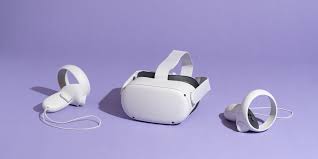Virtual reality (VR) technology has come a long way since its inception, and 2023 promises to be an exciting year for the VR industry. With an increasing number of companies investing in the development of VR headsets, it’s safe to say that VR is becoming more mainstream and accessible to consumers.
If you’re an avid gamer or someone who loves exploring new technology, then you’ll want to keep an eye on the latest VR headsets set to release in 2023. These headsets promise to take your VR experience to a whole new level, with improved graphics, sound, and more realistic haptic feedback.
One of the most highly anticipated VR headsets set to release in 2023 is the Oculus Quest Pro. This headset is said to have a 4K display, improved hand-tracking technology, and an enhanced audio system. Another notable release is the HTC Vive 3, which is expected to have a wider field of view, improved resolution, and a more comfortable design.
But that’s not all – there are also other promising VR headsets expected to release in 2023, such as the PlayStation VR 2, Samsung Odyssey 3, and Pimax 12K. With so many options available, it’s no wonder VR enthusiasts are excited to see what’s in store.
In this article, we’ll take a closer look at the hottest VR headsets set to release in 2023. We’ll explore the features, specs, and expected release dates of these cutting-edge VR devices, so you can get a head start on choosing the perfect headset for your VR adventures.
So what makes a good VR headset?
I tend to judge virtual reality headsets on a few basic criteria: Ergonomics, immersion, and controls. It’s not that hard to shove a mobile display into a plastic headset and strap some cheap elastic headbands onto it. But it takes skill to craft something that’s well-balanced and doesn’t feel uncomfortable after 30 minutes.
Immersion, meanwhile, comes from having high-resolution screens with fast refresh rates, so the visuals are sharp and smooth. Field of view is also a major element, as it describes how well VR screens can cover what you see. Having a low field of view makes it feel like you’re looking through a pair of binoculars, which limits your sense of “presence.” The best VR headsets have a wide field of view that can make it seem like you’re actually flying over the globe on Google Earth.
And when it comes to controllers, the best options fit naturally in your hands and offer accurate tracking. The industry has basically adopted the design of Meta’s excellent touch controllers, but we’re also seeing intriguing leaps forward like Valve’s finger-tracking gamepads.
The best VR headset for most people: Meta Quest 2
Over two years since its release, the Meta Quest 2 remains the best VR headset for the vast majority of consumers. It’s completely cordless, and it’s comfortable to wear for long sessions. Unfortunately, due to supply chain pressures and a worsening economic climate, Meta ended up increasing the Quest 2’s price by $100 this year, making it a $400 headset. It’s still a great device, but it’s also in the strange position of being a worse deal than it was last year.
Here’s what’s still good, though: there’s a huge library of virtual reality titles that you can experience anywhere, and it’s bundled with Meta’s great motion controllers. You can also connect the Quest 2 to a gaming PC to stream more complex VR experiences.
The Quest 2 features fast-switching LCDs with a resolution of 1832×1920 per eye, the highest we’ve seen from Meta. It also has a smooth 90Hz refresh rate, which is impressive for something running entirely on mobile hardware. The Quest 2’s field of view isn’t the best — it’s been measured at just around 90 degrees — but it’s still enough to enjoy most VR experiences. You can also use different face pads to increase its field of view a bit. And if you want an even more comfortable fit, you can snag the Elite head strap for $49 (or $129 with a built-in battery and case).
Meta has recalled the foam inserts from the original model and is offering silicone covers to make the headset more comfortable. We didn’t experience any issues during our review, or during the past year of usage, but there have been enough complaints for Facebook to take action. The base $399 Quest 2 also comes with 128GB of storage, double the space of the original model, giving you even more room to cram in VR games and apps.
The Quest 2 may not offer the best overall VR experience, but it’s certainly the most accessible headset on the market. (At least until we see a potential follow-up next year.)
Best console VR: PlayStation VR2
In many ways, the PS VR2 is the best headset we’ve tested yet. It offers dual 2K OLED HDR screens, effectively giving you 4K quality and an immersive VR experience. It’s one of the most comfortable headsets around. And it has some genuinely refreshing new features, like eye tracking and headset haptics. (Yes, it can literally rock your noggin.) And best of all, the PS VR2 delivers high-quality virtual reality without the need for a $1,000+ gaming PC – all you need is a PlayStation 5.
Now, our recommendation comes with a few caveats. At $550, the PS VR2 is more expensive than the PS5 itself. And it’s unclear how quickly its game library will fill up (the initial run has only a few exclusives, like Horizon VR and Gran Turismo 7). But it’s the easiest way to experience high-end VR, and it’s a major upgrade over the original PS VR.
Best PC VR headset under $600: HP Reverb G2
If you don’t care about wireless VR, and you want to invest a bit more in a high-quality PC virtual reality headset, HP’s $599 Reverb G2 is meant for you. It was developed in cooperation with Valve and has some of the best features from the pricier Index headset, like near-field speakers. The Reverb G2 also has sharp screens, offering 2,160 by 2,160 pixels per eye, a 90Hz refresh rate, and a relatively wide 114-degree field of view.
It’s also the first Windows Mixed Reality headset to include four sensors, which helps to ensure more accurate VR tracking, especially during fast-paced games. I also give HP credit for making a tethered VR headset that’s extremely comfortable thanks to its luxurious cushioning around the eye-piece and rear strap.
The Reverb G2’s motion controllers aren’t my favorite, but they’re still a big step up from HP’s previous model. You could also upgrade it to use Valve’s finger-tracking controllers, but that involves snagging SteamVR sensors and a lot more setups. Still, it’s nice to have the upgrade path available.
Best PC VR headset for gamers: Valve Index
Valve’s Index kit remains one of the best high-end VR solutions on the market for PC gaming. For $999 you get the Index headset, Valve’s finger-tracking controllers, and two SteamVR base stations. While we’ve seen higher-resolution headsets arrive in the last two years, it’s still a very solid option, with a 1,440 by 1,600-pixel resolution, an eye-watering 144Hz refresh rate, and a massive 130-degree field of view. I’d gladly lose a few pixels to get a smoother and more expansive screen, which is still far beyond any other consumer headset.
As a SteamVR product, the Index requires installing two sensors at opposite corners of your room. And of course, it’s wired to your PC. But that clunkiness is worth it for the higher refresh rate and more accurate tracking. Sure, it’s not as easy to use as the Quest 2, but at this price range, we assume you’ll suffer a bit of inconvenience to get a truly high-quality VR gaming experience.
Valve’s finger-tracking controllers are fantastic as well, with a convenient strap that locks them onto your hands. They make playing Half-Life: Alyx feel like a dream. It’s unfortunate that other VR games haven’t fully taken advantage of the finger tracking though.
Best VR quality, no matter the cost: HTC Vive Pro 2
HTC’s Vive Pro 2 is the best-looking PC VR I’ve seen. It has an astoundingly sharp 5K screen and a solid 120Hz refresh rate. Just be prepared: the full kit, which includes the headset, two SteamVR sensors, and wand controllers, costs $1,399. You can also buy the headset separately for $799 as an upgrade to the original Vive Pro, or the Valve Index.
For the price, you get a well-balanced and supremely comfortable VR headset. The Pro 2 is a clear sign that Valve has practically perfected the art of making high-end hardware. I’m less impressed with the large wand controllers, which are exactly the same as the ones that came with the original HTC Vive in 2016. They’re functional, but they’re nowhere near as ergonomic as Oculus’s Touch Controllers.
I’m mainly recommending the Pro 2 here based on the astounding quality of the headset.
True VR fans may want to just grab that separately along with SteamVR base stations and Valve’s finger-tracking controllers. That way you can ensure you have the best experience while playing Pistol Whip.
FAQs
How do VR headsets work?
At the most basic level, a VR headset is simply a high-quality screen that you’re holding up to your face. For a wired headset, the actual work of rendering a game is done on either a PC or a game console. For completely wireless devices, like the Meta Quest 2, that work is handled right on the headset. They rely on either external sensors or sensors built into the headsets, to map your physical space. While you can use a traditional gamepad or keyboard and mouse in VR, they typically use motion-tracking controllers to immerse you in their 3D environments.
What VR headset is best for full-body tracking?
While we’re still waiting for a truly great haptic VR bodysuit to arrive, you can still achieve accurate body tracking with most Steam VR-compatible PC headsets. The Valve Index and HTC Vive Pro 2 both rely on room-tracking sensors that can map your body more effectively than the built-in sensors on competitors. You can also add HTC Vive Trackers to wrist and leg straps, as well as belts, for even better coverage. The Meta Quest 2 doesn’t have any easy body tracking solutions, but you can add Vive trackers when it’s plugged into your PC to mimic a Steam VR headset.
Only a few experiences, like VRChat, take advantage of full body tracking at the moment. Currently, there isn’t anybody tracking solutions for the PlayStation VR and VR2, but we’re intrigued by the company’s Mocopi body trackers, which were really announced in Japan.
What VR headsets are better than Oculus?
Oculus is the previous name for Meta’s VR hardware. Currently, Meta only supports the Quest 2 and Quest Pro, both of which are wireless headsets. As we explain above, PC VR headsets can generally achieve better quality virtual reality, since they rely on more powerful graphics hardware.



